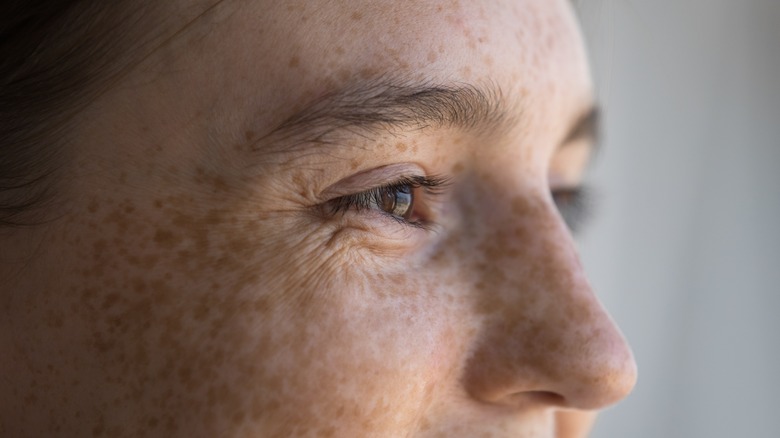When You Should See A Skin Doctor About Your Freckles
You've probably heard that you should have moles checked out regularly by a dermatologist or other healthcare provider, but what about when it comes to freckles? Though they may look similar in appearance, freckles and moles aren't made up of the same elements (via Healthline). Moles are comprised of metastasized, or over-multiplying, skin cells, while freckles are the result of an excess of skin color pigmentation called melanin. Freckles are often emphasized by sun exposure because of their sensitive response to ultraviolet (UV) radiation that provokes an overproduction of melanin.
Some people are born with freckles, while others first develop freckles in adolescence or adulthood, according to Cleveland Clinic. Anyone can have freckles, though people with naturally red or blond hair and fair skin, are more likely to possess visible freckles. Most of the time, freckles are flat areas of colored skin that can appear in various shades of yellow, brown, and red, though there are exceptions when freckles can be uniquely colored or otherwise different in appearance. A type of freckles called skin lentigines, otherwise known as age or liver spots, are prone to develop on the skin of people over age 40 and can have a different appearance than ephelides, the freckles which appear at a young age. Though freckles typically aren't troublesome, skin cancer is a risk for anyone to develop, so freckles should be monitored for any changes. If freckles begin evolving in color, texture, or size, there could be a reason for additional examination.
Knowing the ABCDE method
Even though freckles are different from moles, you can still follow the ABCDE method for determining the level of concern for any spot on your skin. The ABCDE method is commonly used to discern potentially cancerous moles (per Healthline). However, it can be applied to other skin lesions, including freckles, to err on the side of caution. The ABCDE method is an alphabetical mnemonic that can help you keep an eye out for spots on your skin that could be at risk of being cancerous, otherwise known as malignant.
The letters stand for asymmetry, border, color, diameter, and evolving. If you were to draw a line through a spot on your skin to divide the lesion in half and notice that the divided areas aren't symmetrical, then there may be a cause for getting the spot checked out. The same goes for the other components of the mnemonic, like being aware of uneven borders of skin spots, multiple color hues or shades within a single lesion, and a diameter that grows larger than a quarter of an inch. For the final letter of ABCDE, if you realize that a skin lesion has changed in appearance over time in any capacity, such as changes in color, size, texture, or general appearance, then you should make an appointment to have it checked out by a medical professional. Of course, any time you are concerned about anything on your skin, always consult with your healthcare provider.


